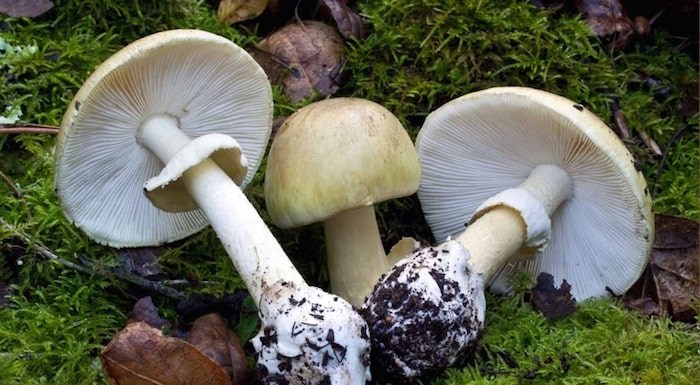 Eating death cap mushrooms may lead to liver and kidney damage as well as death. Photo BC Centre for Disease Control
Eating death cap mushrooms may lead to liver and kidney damage as well as death. Photo BC Centre for Disease Control
B.C. is on track to be a record year for mushroom poisoning calls in 2019, according to the BC Centre for Disease Control.
That is why British Columbians are being urged to use “extreme caution when foraging or consuming wild mushrooms.”
The BCCDC’s poison control centre has received 201 mushroom poisoning calls as of Sept. 30, “well on track to being one of the most active years in recent history,” the centre said. Comparatively, all of 2018 saw a total of 202 calls, an increase from the 161 calls received in 2017.
“Approximately two-thirds of mushroom related poisoning calls in 2019 involved children under the age of five,” said Raymond Li, a pharmacist with poison control, in a news release. “It is important to be aware of dangers from consuming unidentified mushrooms, especially death cap mushrooms. We would like to remind mushroom hunters, parents and pet owners to be vigilant as they enjoy city, parks, forests and even their own backyard.”
Amanita phalloides, also known as the death cap mushroom, has been increasingly popping up in parts of B.C. including Victoria and South Vancouver Island, the Gulf Islands, Metro Vancouver and the Fraser Valley region, said the centre.
“The death cap is the most poisonous mushroom in the world, most often found in urban areas here rather than the natural forest.”
There have been no reported human deaths from B.C. death cap mushrooms since 2016 when a child passed away, however two dogs have died due to possible death cap poisoning this year.
“With increased appearances of death cap mushrooms across B.C. comes increased risk of exposures,” said Paul Kroeger, co-founder, Vancouver Mycological Society. “We urge recreational mushroom hunters to use caution and common sense when foraging wild fungi.”
Tips to stay safe while mushroom hunting:
- If you are unsure, don’t eat it!
- Only pick and eat mushrooms that are well known to be edible and easy to distinguish from poisonous varieties.
- If you suspect you’ve consumed a poisonous mushroom, call the Drug and Poison Information Centre 24-hour phone line at: 1-800-567-8911 and seek medical attention immediately.
- Only hunt for mushrooms in safe terrain and exercise extreme caution if in remote areas.
- Save one of each kind of mushroom so their identities can be confirmed should symptoms develop.
Amanita phalloides (death cap):
- Death cap mushrooms are believed to kill more people worldwide than any other mushroom.
- Death cap mushrooms are native to Europe, and are thought to have been introduced to B.C. on the roots of imported hardwood trees such as the hornbeam, a popular variety that was planted widely in Vancouver in the 1960s and 1970s.
- The fungus lives in the roots of trees for 40 to 50 years before emerging.
- Death caps are particularly dangerous because of their resemblance to edible varieties of mushrooms. They can be mistaken for edible puffballs when young or the Asian Straw mushroom when older.
- Toxins found in death caps include amatoxins, phallotoxins, and virotoxins.
- Symptoms of poisoning include nausea, vomiting, watery diarrhea, low blood pressure, liver failure and kidney failure.
- Illness begins 8 – 12 hours after ingestion, beginning with gastrointestinal symptoms like vomiting and diarrhea, followed by apparent recovery.
Gastrointestinal symptoms recur and damage to the kidney and liver progresses over the next three to six days.



